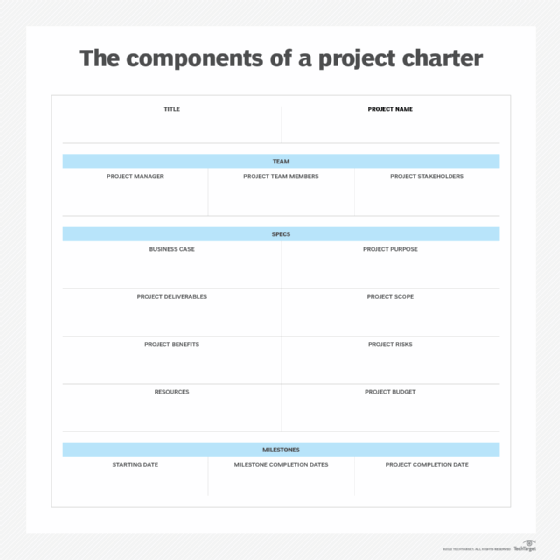What is a project charter? Definition and examples
A project charter is a formal short document stating that a project exists and providing project managers with written authority to begin work. A project charter document describes a project to create a shared understanding of its goals, objectives and resource requirements before the project is scoped out in detail.
Project charters are an important part of project management as they help to plan out the basics of a project and can be referenced throughout the project's lifecycle. The formal document can also show a project's viability and possible return on investment, helping the work to get approved.
The project charter helps project managers explain to participants and stakeholders the scope of a project, the project objectives and who will participate in the project, along with other details such as possible risks. Depending on a company's culture and management style, a charter might serve the same purpose as a business case. In a large organization, the charter might be a multipage document, but in smaller organizations, it might be a few paragraphs with bulleted items.
What to include in a project charter
Project charter templates often include the following parts of a potential project:
- Project goal. This documents the reasons for undertaking the project in clear, concise language. This should determine the project's scope.
- Project participants. This identifies who will be involved in the project and clearly states their roles.
- Stakeholders. This identifies project sponsors or other people who will be directly affected by the project and need to know about its progress.
- Requirements. This identifies the resources required to achieve the project's objectives.
- Constraints. This documents potential roadblocks or bottlenecks and should help prepare participants for the potential issues of the project.
- Implementation milestones. This identifies the start and ideal completion dates, as well as dates for other potentially important checkpoints, like a project schedule.
- Communication. This specifies how the project manager will communicate with project owners, participants and key stakeholders throughout the project.
- Deliverables. This documents what specific products, processes or services the project provides upon completion.
- Cost. This identifies a general overview of the project budget.
The project manager should create the project charter at the beginning of the project. Project stakeholders such as C-suite sponsors, the project management office or the steering committee will review and approve the document. Signing the document can also act to authorize the project -- giving the project manager the go-ahead to officially begin executing the project. This includes the authority to begin employing company funds and resources. For larger projects that are multiphase, project managers can create a charter for each phase.
Tips to create a project charter
To successfully create a project charter, project managers should do the following:
- Keep it short. Each section of the charter can be a few sentences. The project charter should be a high-level overview of a project and not an in-depth breakdown.
- Seek team insights. Communicating to the project team members should aid in creating realistic goals and milestones as well as identifying possible project risks.
- Create and use a charter template. A charter template helps to keep the charter clear and concise. It can also be used to create future project charters.
- Keep it clear. Organize the charter so that its structure is clear at a glance. Label each component of the charter.
- Create an implementation plan. After organizing the charter, project managers should begin planning how to implement it. This includes talking to project members and stakeholders as well as gathering funds and resources.
This document should help make the project management process go smoother as it can be referenced and reviewed throughout the course of the project.
Key components of a project charter
For a basic project charter, the template should include the following components:
- Project name. The project name should be the title of the project, and it should be descriptive enough so that others will understand what the project is.
- Project scope. The project scope should outline any boundaries or limitations to the project's deliverables. For example, the scope should clarify what the project will provide upon completion.
- Risks. The risks section should include the most probable and impactful events that could occur.
- Timeline. The starting, milestone and completion dates also function as a project timeline.
The image below shows an example of a project charter template.

These are the general entries found in a project charter, although the order of components might be changed. The beginning of the charter typically includes the project's general information, like the project's name, description and those involved. The charter should also document each team member's role and responsibilities in the team member section.








